FMCG Company Britannia Plans To Employ More Than 50% Women For Their Workforce To Support Women From Economically Weaker Segment.
The largest FMCG company in India currently employs 41% of women and plans to reach 50% by the end of the next year.

FMCG Company Britannia Plans To Employ More Than 50% Women For Their Workforce To Support Women From Economically Weaker Segment.
According to a top organization official referenced in the publications, Britannia, the largest FMCG company in India, currently employs 41% of women and plans to reach 50% by the end of the next year.
The division has 35 contract and franchisee units spread across India with a workforce of more than one lakh workers, along with 15 company-owned manufacturing factories. In particular, the company employs over 1400 people at its Madurai location, 65% of whom are women.
Almost 900 women work at the Britannia facility, and those who come from the economically disadvantaged group are given additional benefits.
According to an official unit release, the company is considering increasing the percentage of women working in the Madurai unit to 70% by 2024.
The plant currently produces 190 tonnes of various food products every day, and the company has plans to restructure its workforce so that women will make up 70% of it by the end of the current year.

Britannia’s sustainability philosophy, which aims to make it a responsible worldwide total foods company, includes diversity as a key tenet. Every month, Britannia evaluates the success of its diversity program and compares results to goals set for indicators like attrition, engagement, promotion, and recruiting.
The Madurai plant has become recognized as the company’s ideal factory.
Suresh, the head of the Madurai unit, provided a description of the operation of the business and emphasized the tendency of the unit to hire women from economically disadvantaged groups.
According to him, the plant runs three shifts continuously and employs more than 65% of women. The company has made every effort to keep them safe and secure while they are at work in the factory. Women who hail from financially not privileged areas work in the plant.
Women are by nature far better at maintaining hygiene, which is more important for a food factory. Hence, the company is making sure to deliver the correct and safe product for the community by continuing to employ more responsible individuals, he added.
Indranil Gupta, the head of manufacturing at owned factories, responded, they are more hygienic, and fitter for these types of occupations, which is a vital criterion in food processing facilities. They are also more disciplined than male workers.
According to him, having a higher percentage of women in leadership positions has improved factory operations by boosting production and efficiency while also lowering attrition.

According to C S Guruprasad, Regional Manufacturing Head for the South, diversity is a key tenet of Britannia’s sustainability framework for becoming a responsible global food company.
The majority of the women are from agricultural backgrounds, he continued, and they maintained their families during the worst of the Covid pandemic while their husbands or parents were out of work.
Also, the organization offers the best working conditions, in addition to compensation, social security benefits, and transportation services, the official continued.
Companies that sell packaged foods have been increasing pricing and downsizing packaging to protect margins from rising freight and commodity expenses.
Analysts believe that Britannia’s investment in the introduction of new products, including Biscafe and Golmaal biscuits, will help it maintain market share even as customers cut back on discretionary spending.
This contributed to its consolidated total operating revenue from operations rising 17.4% to 41.97 billion rupees in the previous quarter.

The biggest percentage of women are employed in India’s largest private sector company.
According to research, women made up 35% of the workforce at Tata Consultancy Services Ltd. in 2022, or 2,10,000 out of 5,92,195 workers.
The following in line were smaller competitors of the biggest software services firms in India, including Infosys Ltd., Wipro Ltd., and HCL Technologies Ltd. Fifth-placed Reliance Industries Ltd. completed the list.
In the boardroom, there is still a lack of representation for women.
The company with the most women on its board of directors is Apollo Hospitals Enterprises Ltd., with six; it is followed by Godrej Consumer Products Ltd., with five; Piramal Enterprises Ltd., with five; and India Cement Ltd., with five. Two of these four businesses, which is interesting, are run by women.
Many studies and papers analyze India’s low female labor participation rate and the gender disparity in the country’s workforce. To encourage a better knowledge of why female labor/workforce participation (FLWP) in India is so low and what can be done to alter it, however, there haven’t been many meta-analyses that examine public policies, programs, statistics, and research across multiple criteria.
The challenges can be mostly discrimination, gender biases, lack of proper education, etc.
When the husband works, women have traditionally been expected to look after the family and the home. The societal stigma attached to paid work outside the home prevents many women from pursuing careers other than being devoted wives and mothers.
Any economy benefits from having working women. With more women working, most nations experience quicker economic growth. That applies to India as well.
According to a report, India has more employable talent than it had a year ago. In India, the employable workforce climbed from 46.2% to 50.3%, meaning that more persons were found to be employable than were found to be so in the previous year’s data.
Compared to men, who made up 47.2% of the population, more women (52.8%) were judged to be employed. During the past ten years, women’s employability has steadily increased, which is a promising indication of significant developments in India’s evolving labor market.
By 2023, industries that already have significant numbers of women in leadership positions will benefit from increased female participation in the workforce, according to the study.
Edited by Prakriti Arora



